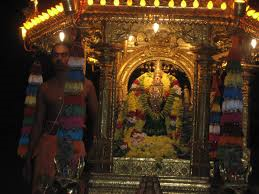
Be positive, think positive.
Positive thoughts, create positive world.
Look around, 'divine' nature is everywhere.
God lives in each one of us, let's discover him.
Lets unfold together, the secrets of nature.
The Kamakshi Temple is a famous
Hindu temple dedicated to Kamakshi, one of the forms of the goddess Parvati. It is located in the historic city of Kanchipuram, near Chennai, India and is popularly associated with Sankaracharya, one of the greatest Hindu gurus. The Meenakshi Temple in Madurai, the Akilandeswari temple in Thiruvanaikaval near Tiruchirappalli and this Kamakshi are the important centers of worship of Parvati as the mother goddess, in the state of Tamil Nadu. The temple was most probably built by the Pallava kings, whose capital was Kanchipuram, around 6 C.E.
The main deity, Kamakshi, is seated in a majestic Padmasana, an yogic posture signifying peace and prosperity, instead of the traditional standing pose. The goddess holds a sugarcane bow and bunch of flowers in the lower two of her arms and has a pasha (lasso), an ankusha (goad) in her upper two arms. There is also a parrot perched near the flower bunch. There are no other Parvati temples in the city of Kanchipuram, apart from this temple, which is unusual in a traditional city that has hundreds of traditional temples. There are various legends that account for this fact. One of them according to Kamakshivilasa is that the Goddess had to absorb all the other shakthi forms to give a boon to Kama, the Hindu god of love.[1] Another legend attributes it to the Raja Rajeswari pose of the deity that signifies an absolute control over the land under the deity's control.[2] Legend has it that Kamakshi offered worship to a Shivalingam made out of sand, under a mango tree and gained Shiva's hand in marriage.
The Old Kamakshi Devi Temple.
The original Kamakshi Devi Temple is what is presently known as Adi Peeteswari or the Adi Peeta Parameswari. This temple is just adjacent to the Kumarakottam, and is near to the presently famous Kamakshi Devi temple.
Adi Shankaracharya, the famous 8th-century CE scholar and saint, established the Sri Chakra at this original Kamakshi Devi temple in the trough-like structure in that shrine, This Sri Chakra soon became the All India famous Kamakoti Peeta. The Acharya's Lalitha Trishati Bhashya comments Kamakoti Peetam as Sri Chakra.
The Acarya changed the fierce form of worship into a sowmya form. The Devi in this original Kamakshi temple is called by various names like Kirtimati, Devagarbha in extant Tantric works like Tantrachudamani. She has four hands containing in each of them respectively, Ankusa, PAsa, Abhaya and a Kapala. This description corresponds to those extant old tantric works. Further, Girvanendra Saraswathi describes precisely this swaroopa as Kameswari.
Kamakshi Devi Temple at Kanchi.
The Siruthondar Puranam of Sekkilar Peruman, written during this time, is aware of both the temples and mentions the original temple as the Yoga Peeta and the present Kamakshi devi temple as Bhoga peetam. The reference to the present Kamakshi Devi as Aram Purappaval (bestower of boons)by Sekilar Peruman is noteworthy, as the present name of the street in which this new temple is located in Kanchipuram is called ArapanakAra Theru.
The present Kamakshi temple too, has a Sri Chakra which was established during the 16th Century by NrusimhAdvari, of the famous dathamAnji family. There is a stone inscription inside the new temple, near this Sri Chakra, which states this fact. It is noteworthy that Arunagirinathar a 15th Century Tamil Saint, sings in praise of the Goddess as devi of dark emarald complexion and the mother of Muruga of Kumarakottam. The Original Kamakshi Devi temple i.e. Adi PeeteswariKamakshi Devi temple is just adjucant to the Kumarakottam. Arunagirinathar mentions the Sri Yantra in the Kamakshi Devi temple, which can apply, during the 15th century, only to the original Adi Peeteswari Kamakshi Devi, which contained the Sri Chakra installed by Adi Shankara. Arunagirinathar does not make any reference to the new temple.
Festivals.
Four worship services are offered each day. The annual festival falls in Spring, in the Tamil month of Masi, which runs from mid-March to mid-April. During this time the chariot festival (Ther) and lake festival, (Theppam) are held. Other festivals include Navaratri, Aadi and Aippasi Pooram, Sankara Jayanthi and Vasanta Utsavam in the Tamil month of Vaikasi. All Fridays are considered sacred, though the Fridays in the Tamil months of Adi (mid-July to mid-August) and Thai (mid-January to mid-February) are celebrated.
BEEJ MANTRAS | |||
| |||
The encompassing circle is avidya (ignorance);the eight petalled lotus is the eight-fold Prkriti consisting of earth, wter, fire, air, ether, manas (mind), buddhi (intellect) and ahamkara (egoism); the five triangles are the five jnanendriyas (jnana, knowledge; indriyas, senses), the five karmendriyas (motor organs) and the five pranas (breathing activities); and the bindu which is pure consciousness reflected in maya in the bija